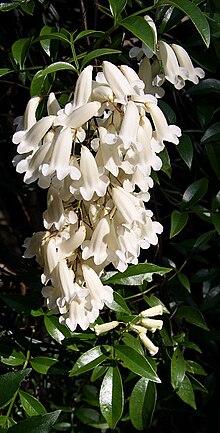en
names in breadcrumbs


Pandorea is a genus of nine species of flowering plants in the family Bignoniaceae and is native to Australia, Malesia, New Guinea and New Caledonia. Plants in the genus Pandorea are mostly woody climbers with imparipinnate leaves arranged in opposite pairs, flowers in groups with tube-shaped flowers, and winged seeds.
Plants in the genus Pandorea are woody, evergreen climbers, rarely shrubs and have imparipinnate leaves arranged in opposite pairs and do not possess tendrils. The flowers are arranged on the ends of the stems or in upper leaf axils, sometimes appearing as racemes, each flower on a pedicel. The five sepals are fused at the base forming a bell-shaped or cup-shaped tube with short lobes. The five petals are joined at the base with two "lips" and there are two pairs of two stamens. The fruit is a capsule containing many flat, winged seeds.[2][3][4][5]
In 1838, Stephan Endlicher described the genus Pandorea, initially as a section of the genus Tecoma, in Édouard Spach's monograph Histoire Naturelle des Vegetaux. Phanerogames.[6][7][8] The genus name is a reference to Pandora of Greek mythology who opened a jar (Pandora's box) releasing all the evils of humanity, alluding to the many-seeded capsules produced by species of Pandorea.[9]
The following is a list of Pandorea species accepted by Plants of the World Online as of October 2021:[10]
{{cite book}}: |first2= has generic name (help)  Pandorea doratoxylon
Pandorea doratoxylon  Pandorea pandorana
Pandorea pandorana Pandorea is a genus of nine species of flowering plants in the family Bignoniaceae and is native to Australia, Malesia, New Guinea and New Caledonia. Plants in the genus Pandorea are mostly woody climbers with imparipinnate leaves arranged in opposite pairs, flowers in groups with tube-shaped flowers, and winged seeds.